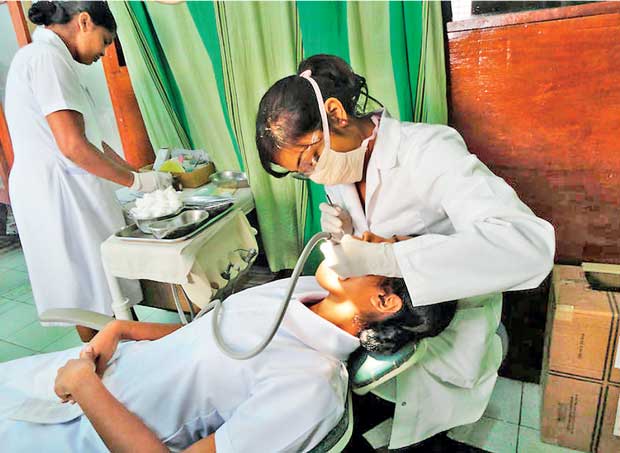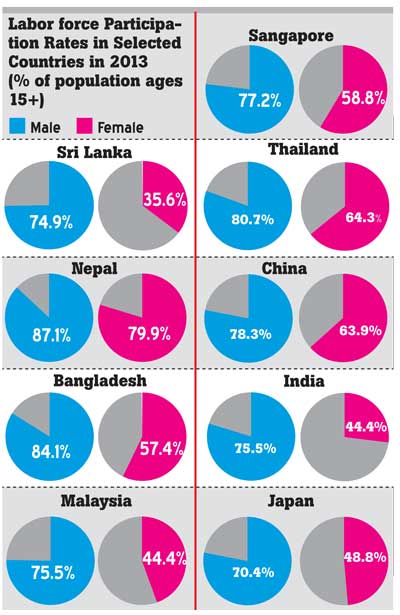25 May 2016 - {{hitsCtrl.values.hits}}

Women’s contribution to the Sri Lankan economy is remarkable as major foreign exchange earning sectors comprise larger proportion of women. Yet, Sri Lanka’s female labour force participation is behind many Asian nations.
Presently, Sri Lanka’s female labour force participation rate is around 35 percent compared with male participation rate of 75 percent. However, female labor force participation in selected Asian countries particularly Singapore, Japan, Thailand, China and Bangladesh remain in the range of around 50 percent to 65 percent.
Sri Lankan women possess 92.6 percent of literacy rate which is above its regional peers and the share of female students enrollment in university undergraduate level is around 60 percent. Surprisingly, this remarkable educational achievement of Sri Lankan women is not portrayed in the economic participation highlighting a significant gap in transforming available human resource potential productively to generate economic outcome measured in GDP and the national wealth.

Socio economic transformations and labour force
Indeed, Sri Lanka’s demographic transition with the rapidly ageing population creates critical labour crunch in several sectors whereas promising growth potential of the service sector of the economy requires more female skilled labor input. In this given context, increased women’s economic participation is necessarily important to maintain the desired economic growth momentum.
Further, United Nation’s Sustainable Development Goals also emphasizes to ensure that all human being can fulfill their potential in dignity and equality paying attention to achieve gender equality and empower all women and girls.
So what can be done?
Of course, majority of women are taking up household responsibilities including caring for children and elderly which take priority over working for wages outside home. In line with this, women being married and having young children reduces women’s participation in the labor force significantly in most countries.
More women’s economic participation could be induced with the introduction of women positive cooperate environment, supportive human resource policies and working arrangements in view of relieving the pressure of care-giving responsibilities and balancing their career with family responsibilities.
Accordingly, flexible working hours, part-time jobs, working from home, establishing more day care centers both in urban and rural settings to provide quality of care at the affordable rates could be considered.
Accelerated economic growth – a must!
Sri Lanka’s present economic expansion activities are not adequate to absorb the larger proportion of current economically inactive women into labor force.
Accelerating the economic growth is a must and fast export-oriented industrialization is instrumental with the support of International Corporation and foreign direct investment to create substantial employment opportunities for women whilst taking labor intensive industries and commercial business ventures to rural villages would enable rural women to find employment opportunities in their own villages.
The garment industry in Bangladesh and Sri Lanka is an ideal example for enhanced economic participation of women and uplifting of rural economy.
Moreover, economic reform agenda should focus on fostering more women entrepreneurs, with the necessary support on capital, markets, technology and training to grow their business successfully.
Additionally, women should be encouraged to follow more job-oriented educational streams and acquire market oriented skills such as fluency in languages and ICT and soft skills mainly communication, leadership, and problem solving will boost the job prospects and convert them as successful professionals.
Change in attitude
Socio Cultural factors such as traditional attitudes, social norm and practices also restrict women participating in the labor force. Many still perceive women to be fully caregivers at home limiting women’s ability to make economic contribution. Hence, promoting greater awareness is critical to change the mindset of women who still doubts about taking up jobs and the general attitude to stimulate women to join a work place to build fulfilling careers outside homes.
Political empowerment
Interestingly, the Government endeavor enabling 25 percent female representation in local government bodies is encouraging, as it could improve political, social and economical leadership role played by women significantly.
Conclusion
Overall, the economic participation of women is essential to sustain the economic growth momentum in a changing socio economical landscape. A strong collective effort of various stakeholders particularly government, companies, investors and citizens is critical to create supportive environment which enhance women’s labor force participation, which will not only empower women but also improve family living standards, uplift rural economy and leads to overall economic prosperity of the nation.
(The writer is an Assistant General Manager of a leading organization. He is a graduate of the Chartered Institute of Marketing of United Kingdom and Wayamba University of Sri Lanka. You can share your feedback on [email protected])
10 Jan 2025 1 hours ago
10 Jan 2025 2 hours ago
10 Jan 2025 3 hours ago
10 Jan 2025 5 hours ago
10 Jan 2025 5 hours ago